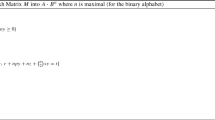Abstract
The relationship between the set of productions of a context-free grammar and the corresponding set of defining equations is first pointed out. The closure operation on a matrix of strings is defined and this concept is used to formalize the solution to a set of linear equations. A procedure is then given for rewriting a context-free grammar in Greibach normal form, where the replacement string of each production begins with a terminal symbol. An additional procedure is given for rewriting the grammar so that each replacement string both begins and ends with a terminal symbol. Neither procedure requires the evaluation of regular expressions over the total vocabulary of the grammar, as is required by Greibach’s procedure.
This work was written while the author was a National Science Foundation Graduate Fellow.
Access this chapter
Tax calculation will be finalised at checkout
Purchases are for personal use only
Preview
Unable to display preview. Download preview PDF.
Similar content being viewed by others
References
D. N. Arden. Delayed logic and finite state machines. In Theory of Computing Machine Design, pages 1–35. Univ. of Michigan Press, Ann Arbor, 1960.
J. A. Brzozowski. A survey of regular expressions and their applications. IRE Trans., EC-11:324–335, 1962.
J. A. Brzozowski and E. J. McCluskey Jr. Signal flow graph techniques for sequential circuit state diagrams. IEEE Trans., EC-12:67–76, 1963.
N. Chomsky, Formal properties of grammars. In R. D. Luce, R. R. Bush, E. Galanter, editors, Handbook of Mathematical Psychology, volume 11, pages 323–418. Wiley, New York, 1963.
N. Chomsky and M. P. Schutzenberger. The algebraic theory of context-free languages. In P. Braffort and D. Hirshberg, editors, Computer Programming and Formal Systems, pages 118–161. North-Holland, Amsterdam, 1963.
S. Ginsberg and H. G. Rice. Two families of languages related to ALGOL. J. ACM, 9(3):350–371, 1962.
S. Greibach. A new normal-flow theorem for context-free phrase structure grammars. J. ACM, 12(1):42–52, 1965.
S. C. Kleene. Representation of events in nerve nets and finite automata. In C. E. Shannon and H. McCarthy, editors, Automata Studies, pages 3–41. Princeton Univ. Press, Princeton, 1956.
R. McNaughton and H. Yamada. Regular expressions and state graphs for automata. IRE Trans., EC-9(1):39–47, 1960.
Author information
Authors and Affiliations
Editor information
Editors and Affiliations
Rights and permissions
Copyright information
© 2009 Springer Science + Business Media B.V.
About this chapter
Cite this chapter
Rosenkrantz, D.J. (2009). Matrix Equations and Normal Forms for Context-Free Grammars. In: Ravi, S.S., Shukla, S.K. (eds) Fundamental Problems in Computing. Springer, Dordrecht. https://doi.org/10.1007/978-1-4020-9688-4_1
Download citation
DOI: https://doi.org/10.1007/978-1-4020-9688-4_1
Publisher Name: Springer, Dordrecht
Print ISBN: 978-1-4020-9687-7
Online ISBN: 978-1-4020-9688-4
eBook Packages: Computer ScienceComputer Science (R0)




